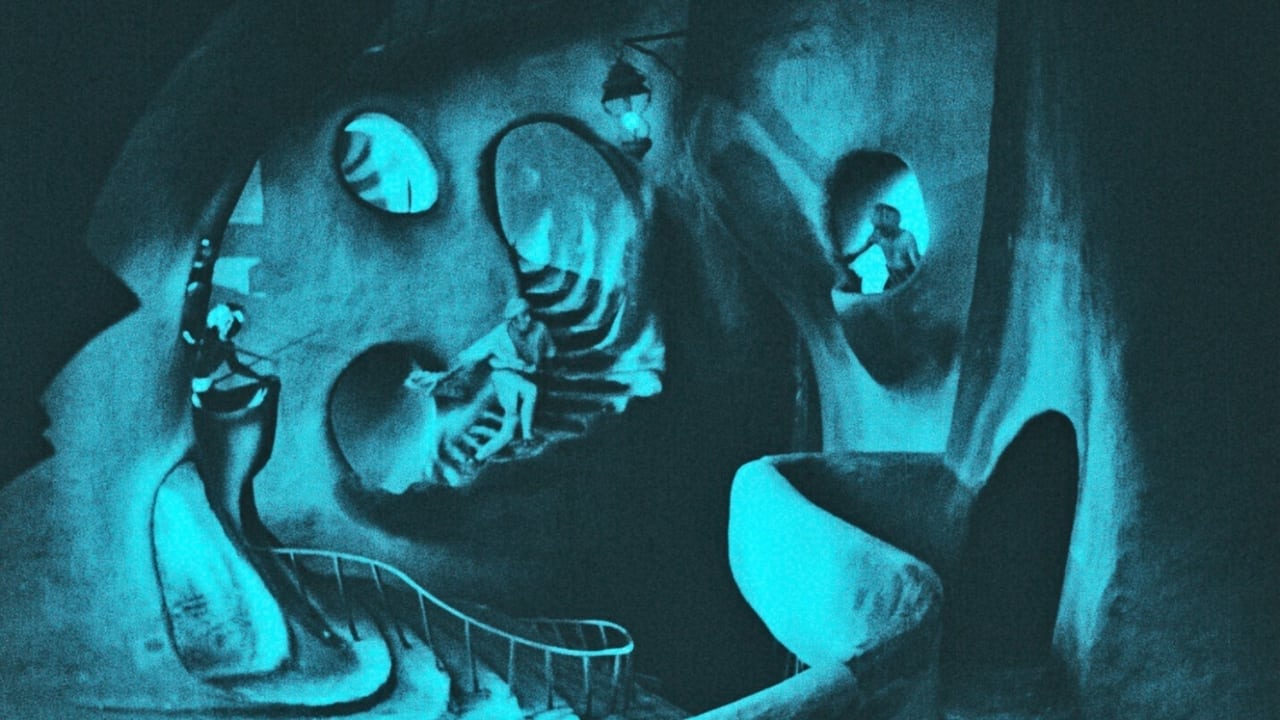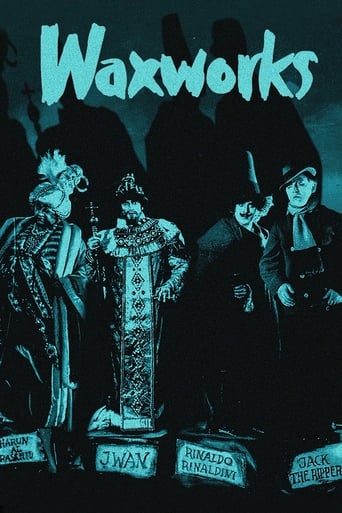Tedfoldol
everything you have heard about this movie is true.
Neive Bellamy
Excellent and certainly provocative... If nothing else, the film is a real conversation starter.
Lucia Ayala
It's simply great fun, a winsome film and an occasionally over-the-top luxury fantasy that never flags.
Nicole
I enjoyed watching this film and would recommend other to give it a try , (as I am) but this movie, although enjoyable to watch due to the better than average acting fails to add anything new to its storyline that is all too familiar to these types of movies.
Johan Louwet
This movie predates The Mystery of the Wax Museum by 9 years. Where the latter is obviously horror/mystery/thriller/crime this German movie I would rank more in the fantasy genre with some mild horror elements. So the wax statues of Harun al Raschid, Ivan the Terrible and Jack the Ripper do not come to life for real only in the stories which are written and told by William Dieterle to his employee Olga Belajeff. Both of them play various roles in the 3 stories. The best story I thought was the first about the baker in the Far East who thought he had chopped of the arm of the sultan. I thought it was clever and humorous. The second story is about Ivan the Terrible is a lot darker but not so well executed, seems rather rushed. Conrad Veidt though is perfectly cast in this role. I have seen him also in Orlacs Hände and Cabinet of Dr. Caligari, really fine actor. The last story is too short and silly to rate. Good idea but I had preferred if they stuck to 1 story and made it more horror.
FerdinandVonGalitzien
"Das Wachsfigurenkabinett" (1924) is Herr Paul Leni's most well-known film during his German period. Its probably the most representative of his artistic virtues, an oeuvre composed of three episodes ( although Herr Leni planned a fourth episode that never was done ) in where an imaginative writer ( Herr Wilhelm Dieterle ) applied for publicity work in a waxworks exhibition in which he is commanded to write startling tales about three different wax figures: Ivan the Terrible, Czar of all the Russias ( Herr Conrad Veidt ), Haroun Al Raschid, Caliph of Bagdad ( Herr Emil Jannings ) und the murderer Spring Heeled Jack ( Herr Werner Krauss ). The young writer and the showman's daughter ( Frau Olga Belejeff ) link the three different episodes.The three episodes are stylistically and technically very different from each other and certainly Herr Leni explored his most imaginative resources and fond subjects ( oneiric décors connected with fantastic subjects ) using them appropriately to fit the characteristics of the story depicted in the episode in question.The first one, which relates the story of the satyr and easy-going Caliph of Bagdad, features the beautiful and evocative décors that apprehend the necessary mood for an episode in which humour and parody over the iconic Western view of an idealized Arab atmosphere. The classic adventures that inspired them, is in the air, benefiting the episode with such exaggerated tastes which are absolutely charming; Herr Jannings certainly enjoys a lot such parody role.The second episode depicts Ivan the terrible as a merciless monarch who ruled the Russian empire with an iron fist by subjecting the citizens to severe cruelty. This time Herr Leni combine drama with fantastic elements, achieving a bizarre and disturbing atmosphere. Again a superb actor, as it happened in the preceding episode steals the picture thanks to his magnetic and fascinating presence.Once again, the décors are outstanding although this time Herr Leni uses these in a "conventional" way. That is to say, in order to illustrate in a careful and more realistic way, the characteristics of the Russian empire of the time, the German director leaves the most fantastic aspects of the story for the torture chamber sequences and its terrible ending.The third episode is Expressionism at its best, or maybe this Herr Graf should say that is a homage to Expressionism (on the other hand, the same that happens with the other two episodes in where the main subject are treated in a hyperbolic stylistic way ).This time, the imaginative writer has a terrible nightmare in which he is chased by Spring Heeled Jack. Herr Leni takes advantage of such an oneiric atmosphere in an episode that technically is more complex than the other two. He uses double exposures and special effects in a continuous nightmarish sequence in which quintessential "Expressionism" is displayed in an effective and accomplished way."Das Wachsfigurenkabinett" is certainly a condensed version of Herr Leni's artistic achievements. It's an excellent example of his many skillful virtues and stylistic resources, stamped with his particular and fascinating own imaginary.And now, if you'll allow me, I must temporarily take my leave because this German Count must remove in a Teutonic way the depilatory wax from the whole body of one of this Herr Graf's rich heiress.
Boba_Fett1138
This is a movie that features 3 kind of different stories, when the owner of a wax museum hires a writer to write 3 stories for 3 of his models; Harun al Raschid, Ivan the Terrible and Jack the Ripper. It provides the movie with 3 different stories, set at different times and each with a new different main character, played by the finest 3 German actors of their time period. It's a very creative and interesting concept, also of course really when considering that this movie got made in 1924.In order to keep all of the stories still somewhat connected and make the movie more coherent as a whole, all of the stories feature the two actors William Dieterle and Olga Belajeff, each time in different roles. But when you have 2 stories of about halve an hour and then another one of just 5 minutes, can you still really call this movie a coherent one? It can be presumed that budgeting reasons was the reason why the last story of the movie is so much shorter. It was originally even planned to shoot a fourth story about Rinaldo Rinaldini. The character can still be seen at the start of movie, standing between the other waxed characters. Even though all stories are different and set in completely different time periods, they still have the same overall style over it, which still is a reason why this movie still feels like a whole one.All the episodes are good looking but the stories for it aren't always that interesting. Basically since it at times it kind of dragging and despite some early action and adventure elements, the movie still is sort of a lackluster. Well lack-lusting perhaps isn't the right way to describe it. It's more that it's not really engaging enough at all times.But of course the looks and style of the movie compensate a lot. This is a real expressionistic German movie, with some fantastic distinctive expressionistic sets. That alone already makes this movie for the lovers of German expressionistic style an absolute must-see.It's absolutely a great fact that this movie features Emil Jannings, Conrad Veidt and Werner Krauss, who were really the biggest, best known and best German actors of their time. The movie also features William Dieterle, who later gained more fame as a director of movies such as "The Life of Emile Zola" and the 1939 version of "The Hunchback of Notre Dame", with Charles Laughton.It's basically a fun entertaining movie from the early '20's, that is truly worth watching for plenty of reasons.8/10http://bobafett1138.blogspot.com/
pioner-3
I really enjoyed that film. It's not a masterpiece, like "Caligari" or "Nosferatu", but a good fun film anyway. Veidt and Jannings are wonderful. The first part, about Haroun al Rashid (played by Emil Jannings), is very humorous (and funny as well), with well written plot. The second part, about Ivan the Terrible (played by Conrad Veidt), is, in contrast, very dark and depressing. In my humble opinion, it is much better than Eisenstein's movie (which also steals shamelessly from it); for sure, Veidt is better than Cherkasov. The third story is something really weird: it starts and suddenly ends, like the crew ran out of money.So, a lot of humour in the first part, a lot of "Russian gothic" ;-) in the second part, good acting, good plot, great sets -- if you like silent movies (especially expressionist silent movies), don't miss this one!P.S. If you like silent movies and still haven't seen "Cabinet of Doctor Kaligari" and "Nosferatu, symphony of horror", see them first -- they are better than "Waxworks"!

